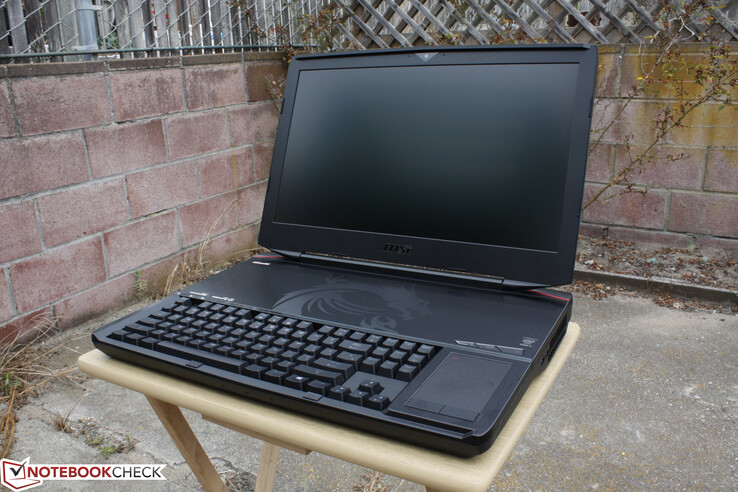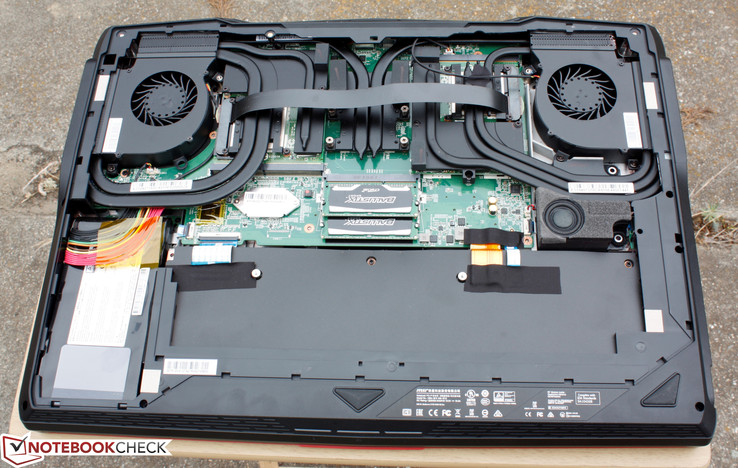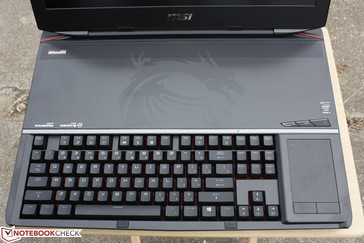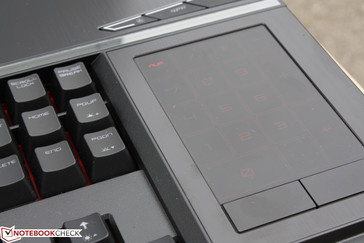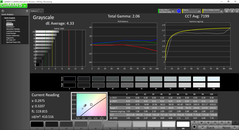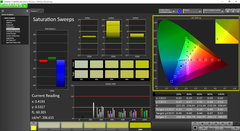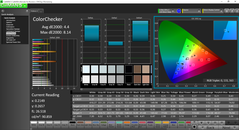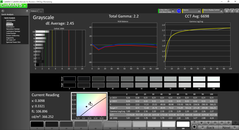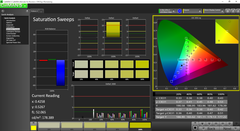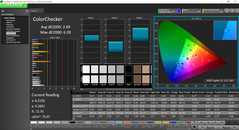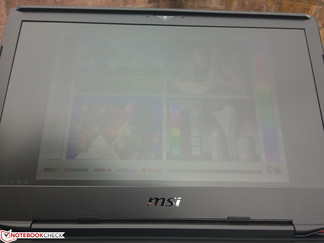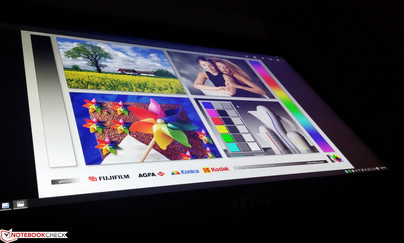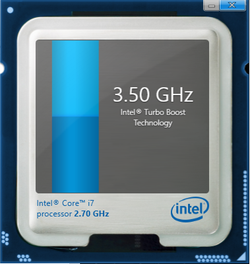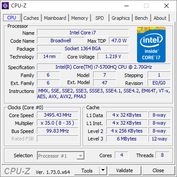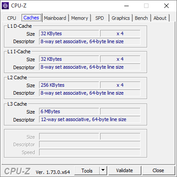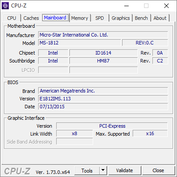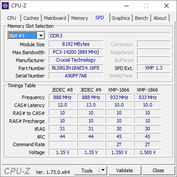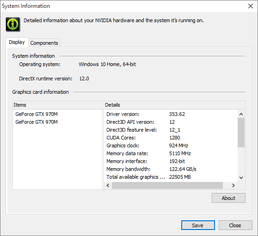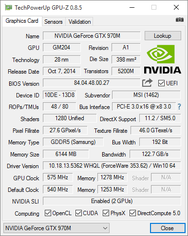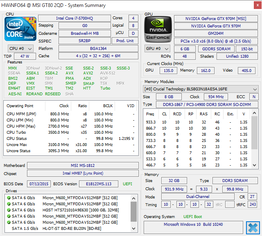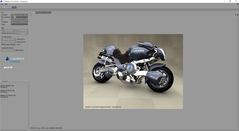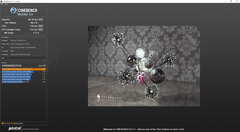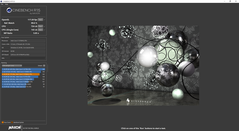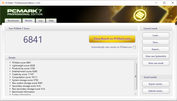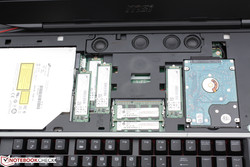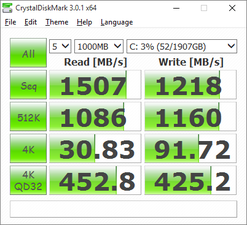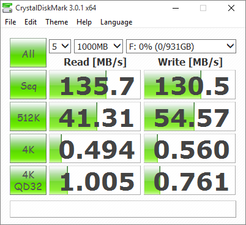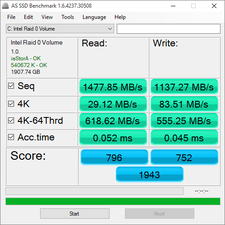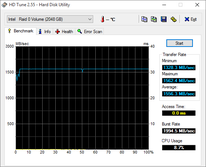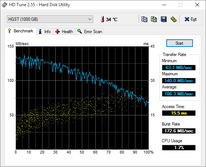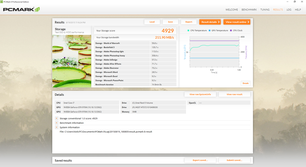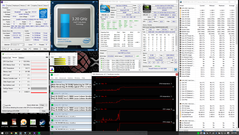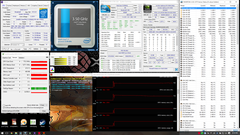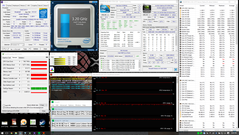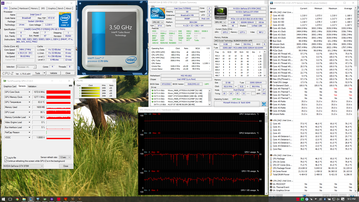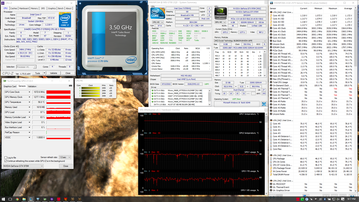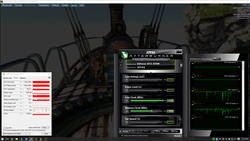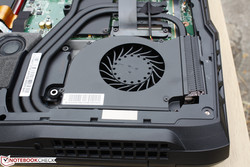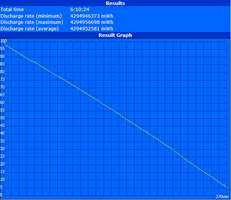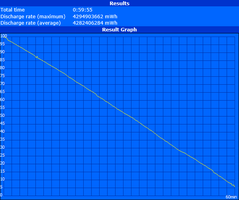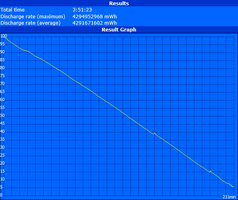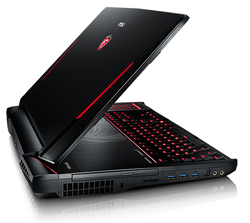MSI GT80 2QD Titan Notebook Review
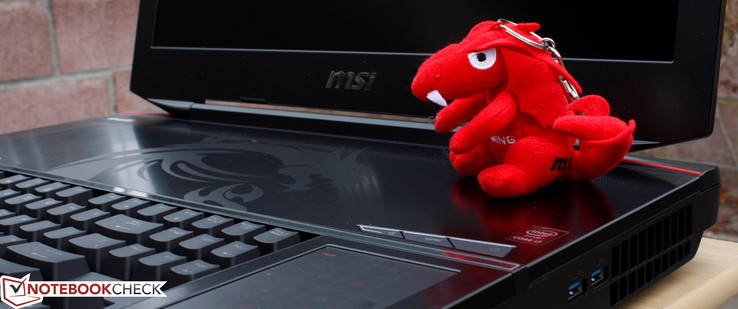
The GT80 series is MSI's capstone in its lineup of gaming notebooks. Whereas manufacturers like Aorus revel in thinner and thinner designs, the GT80 remorselessly looks the other way to offer something equally unique at a gargantuan size.
We've encountered the GT80 earlier this year with Haswell and GTX 980M SLI GPUs, so we encourage users to check out our previous full review for more details and pictures on case quality, features, connectivity, and display. Instead, our model today carries Broadwell with GTX 970M SLI GPUs and we'll be touching on overclocking potential that was omitted in our last review. Do the newer CPU and GPUs allow for more breathing room and even faster performance?
Case
Case quality is very good from top to bottom as the hard plastic and brushed aluminum surfaces feel thick and do not warp from applied pressure. The lid in particular is very sturdy and is much thicker compared to other consumer notebooks. Our first reviewer did not like the quality of the lid, but its resistance to twists and depressions are definitely above average. Its hinges could use improvement as the display can still rock back and forth when adjusting angles. We were expecting better hinges especially for a notebook of this class.
As for size, there are not many other current 18-inch gaming notebooks to compare to. The Alienware 18 and Eurocom X8 are both notably thicker than the GT80, while the GT80 is heavier than the Eurocom by about 500 grams and lighter than the Alienware by over 700 grams. It's impressive that MSI is able to integrate a mechanical keyboard without needing to be even thicker or heavier than existing 18-inch gaming notebooks.
Connectivity
Port placement is biased towards right-handed users as noted in our first review. The left-hand ports are close to the front and can clutter quickly. The notebook is also missing Thunderbolt and support for external desktop GPUs as found on newer Alienware notebooks and the recent MSI GS30. An HDMI-in port would also be an excellent addition.
Communication
WLAN and Bluetooth are provided by the gaming-class Killer Wireless-AC 1525 M.2 (NGFF) module. The dual-band card is a common find on high-end gaming notebooks and from resellers such as Eurocom and Maingear. Its manufacturer promises reduced latency compared to non-gaming 802.11ac solutions. Despite this, this is not a gigabit WLAN card as maximum theoretical transfer rate is a bit less at 867 Mbps.
There are no options for GPS or WWAN as is usual for gaming notebooks.
Maintenance
The bottom cover can be easily removed via a standard Philips head screwdriver. It's not as quick to remove as on Clevo barebones, however, as there are many more screws and notches around the edges. Nonetheless, users have plenty of space to work with and easy access to core components. Note that the CPU is soldered while the GPUs use standard MXM 3.0b slots.
Accessories
Plenty of accessories are included such as the dragon keychain (as seen above), warranty brochure, Quick Start guide, mouse pad, golden metal WASD keys, palm rest, driver DVDs, and a USB mouse. Notably absent is a pair of headphones, which even the recent Asus ROG G501 includes for free. The included mouse is a good backup as owners are likely to have an existing and superior gaming mouse.
Warranty
Limited warranty is 24 months from date of purchase whereas most other notebook manufacturers offer only 12 months in the U.S.. Buyers can get a free year of accidental damage coverage if they register their purchases with MSI. The manufacturer does not cover dead pixels, so Xotic PC offers its own coverage for an additional $35 USD.
Input Devices
Keyboard
To some users and especially gamers, jumping from membrane-type keyboards to mechanical keyboards can feel like moving up from dial-up modem to DSL. The integrated MX Brown Cherry keyboard (34 x 12 cm) is what defines the GT80 -- not its size, weight, or SLI graphics as there are other gaming notebooks with these features.
As noted in our previous review, these keys provide firm and very precise feedback. They are very light and require minimum force to push, which make typing both easier and quicker. For gamers, the four WASD keys are able to be registered simultaneously if needed and can also be replaced with the golden metal keys for extra visual flare.
While the mechanical keyboard easily trumps the Chiclet keyboards on other gaming notebooks, it isn't perfect on the GT80. Longer keys tend to rock in place and don't feel as solid, such as the Shift, Back Space, and Space Bar keys. Otherwise, the main QWERTY keys are fantastic to use.
Overtly missing keys include dedicated volume and multimedia and Macro keys. There only two auxiliary keys are to toggle between the dGPU and iGPU and the maximum fan speed.
Touchpad
The integrated touchpad is just 6 x 9 cm (excluding the dedicated mouse keys) and looks tiny compared to the hulking surface area that surrounds it. The smooth surface responds swiftly with no jumping cursor issues and even supports three-finger multi-touch via the Synaptics software. Its size and shape, however, is of course not ideal for the large widescreen.
The touch-Numpad overlay replaces the standard Numpad on a full-size keyboard. While the idea looks neat, the lack of feedback is a detriment to its usability. We would like to see haptic feedback if MSI continues to include the touch Numpad on future GT80 revisions. Of course, the touchpad and mouse keys are inactive when the Numpad is activated.
Unlike the loud mechanical keys, the mouse keys offer shallow travel and are actually quite quiet. Feedback is also uneven between the two keys as the left click feels softer than the right click. Users are expected to use the integrated touchpad only when an external mouse is not available.
Display
The matte Super PLS panel is a high quality panel with no major screen-door effects, backlight bleeding, or grains on the screen. A quick search for its XJY7J_184HL panel name shows that the Alienware 18 sports an identical panel albeit with a glossy surface. Display brightness is more than enough for indoor use and contrast is as good as competing high-end gaming notebooks like the 17.3-inch Asus G751 and Eurocom P7 Pro. Brightness distribution, however, could be a bit better on this large screen.
| |||||||||||||||||||||||||
Brightness Distribution: 86 %
Center on Battery: 365 cd/m²
Contrast: 971:1 (Black: 0.376 cd/m²)
ΔE ColorChecker Calman: 4.4 | ∀{0.5-29.43 Ø4.79}
ΔE Greyscale Calman: 4.33 | ∀{0.09-98 Ø5}
88% sRGB (Argyll 1.6.3 3D)
57% AdobeRGB 1998 (Argyll 1.6.3 3D)
64.6% AdobeRGB 1998 (Argyll 3D)
88.3% sRGB (Argyll 3D)
64.6% Display P3 (Argyll 3D)
Gamma: 2.06
CCT: 7199 K
| MSI GT80 Titan SLI | Alienware 18 | MSI GT72-2QE16SR21BW | Asus G751JY | Eurocom P7 Pro | |
|---|---|---|---|---|---|
| Display | -3% | 0% | -3% | -1% | |
| Display P3 Coverage (%) | 64.6 | 62.7 -3% | 68.1 5% | 65.9 2% | 67.2 4% |
| sRGB Coverage (%) | 88.3 | 85.9 -3% | 86.7 -2% | 83.1 -6% | 85.3 -3% |
| AdobeRGB 1998 Coverage (%) | 64.6 | 62.9 -3% | 63.4 -2% | 60.8 -6% | 62.4 -3% |
| Screen | -10% | -14% | 1% | -5% | |
| Brightness middle (cd/m²) | 365 | 342 -6% | 285 -22% | 329 -10% | 335.4 -8% |
| Brightness (cd/m²) | 332 | 315 -5% | 278 -16% | 320 -4% | 319 -4% |
| Brightness Distribution (%) | 86 | 87 1% | 87 1% | 92 7% | 88 2% |
| Black Level * (cd/m²) | 0.376 | 0.38 -1% | 0.45 -20% | 0.34 10% | 0.384 -2% |
| Contrast (:1) | 971 | 900 -7% | 633 -35% | 968 0% | 873 -10% |
| Colorchecker dE 2000 * | 4.4 | 5.85 -33% | 5.1 -16% | 4.13 6% | 5.14 -17% |
| Greyscale dE 2000 * | 4.33 | 5.6 -29% | 5.23 -21% | 3.72 14% | 4.44 -3% |
| Gamma | 2.06 107% | 2.04 108% | 2.32 95% | 2.36 93% | 1.98 111% |
| CCT | 7199 90% | 6645 98% | 7565 86% | 6352 102% | 6464 101% |
| Color Space (Percent of AdobeRGB 1998) (%) | 57 | 59 4% | 57 0% | 55 -4% | 56.1 -2% |
| Color Space (Percent of sRGB) (%) | 88 | 87 -1% | 83 -6% | 85.3 -3% | |
| Colorchecker dE 2000 max. * | 8.01 | ||||
| Total Average (Program / Settings) | -7% /
-8% | -7% /
-11% | -1% /
0% | -3% /
-4% |
* ... smaller is better
Color coverage is roughly 57 percent and 88 percent of AdobeRGB and sRGB spectra, respectively. These are higher than our previously recorded measurements due to corrections in our method for comparisons, but still lower than the claimed 100 percent sRGB coverage by MSI. Cheaper and more mainstream displays typically cover less than 40 percent and 60 percent of AdobeRGB and sRGB, respectively. While this is more than sufficient for games, the Asus G501 and UX501 are closer to 100 percent sRGB coverage to better appeal to graphics designers.
Further color analyses with an X-Rite spectrophotometer reveal accurate colors and grayscale out-of-the-box. A quick calibration will result in an even more accurate display, though Orange and Yellow colors remain slightly more inaccurate than the others. Accuracy decreases as color saturation increases due to the imperfect sRGB coverage.
Performance
The GT80 hardware update includes a move from the already high-end Core i7-4980HQ on our original model to the newer Core i7-5700HQ. This Broadwell core can run up to 3.5 GHz on all cores with Turbo Boost, but will otherwise run at 800 MHz if on the Power Saver profile. This is compared to the i7-4980HQ, which can go up to 4.0 GHz for a single active core. Our GPU configuration is different as well with dual GTX 970M GPUs. Both GPUs will run at 135/162 MHz core/memory each when on the Power Saver profile.
Our system RAM is at its maximum 32 GB capacity with all four SODIMM slots occupied. Latencymon shows no latency spikes when on desktop with wireless active.
Processor
The Core i7-5700HQ isn't necessarily a vertical upgrade compared to the i7-4980HQ in our first GT80. Multi-threaded benchmark scores for the i7-5700HQ are just a few percentage points above the Haswell core, while Single-threaded benchmark scores favor the Haswell core instead. This is expected since the i7-4980HQ has the faster Turbo Boost for single-threaded operations. Meanwhile, the i7-5700HQ is better able to maintain consistent multi-core Turbo Boost and so it gains a slight lead in multi-threaded operations.
The even faster and more power-hungry desktop Core i7-4790K in the Eurocom P5 Pro is still roughly 20 percent faster in either case.
More technical data and benchmarks on the Core i7-5700HQ can be found on our dedicated CPU page here.
| Cinebench R15 | |
| CPU Single 64Bit (sort by value) | |
| MSI GT80 Titan SLI | |
| Eurocom P5 Pro Extreme | |
| MSI GT80 Titan SLI PL | |
| Aorus X3 Plus v3 | |
| Asus UX501JW-DS71T | |
| Lenovo IdeaPad Y50 | |
| CPU Multi 64Bit (sort by value) | |
| MSI GT80 Titan SLI | |
| Eurocom P5 Pro Extreme | |
| MSI GT80 Titan SLI PL | |
| Aorus X3 Plus v3 | |
| Asus UX501JW-DS71T | |
| Lenovo IdeaPad Y50 | |
| Cinebench R11.5 | |
| CPU Single 64Bit (sort by value) | |
| MSI GT80 Titan SLI | |
| Eurocom P5 Pro Extreme | |
| MSI GT80 Titan SLI PL | |
| Aorus X3 Plus v3 | |
| Asus UX501JW-DS71T | |
| Lenovo IdeaPad Y50 | |
| CPU Multi 64Bit (sort by value) | |
| MSI GT80 Titan SLI | |
| Eurocom P5 Pro Extreme | |
| MSI GT80 Titan SLI PL | |
| Aorus X3 Plus v3 | |
| Asus UX501JW-DS71T | |
| Lenovo IdeaPad Y50 | |
| Cinebench R10 | |
| Rendering Single CPUs 64Bit (sort by value) | |
| MSI GT80 Titan SLI | |
| Eurocom P5 Pro Extreme | |
| MSI GT80 Titan SLI PL | |
| Aorus X3 Plus v3 | |
| Asus UX501JW-DS71T | |
| Lenovo IdeaPad Y50 | |
| Rendering Multiple CPUs 64Bit (sort by value) | |
| MSI GT80 Titan SLI | |
| Eurocom P5 Pro Extreme | |
| MSI GT80 Titan SLI PL | |
| Aorus X3 Plus v3 | |
| Asus UX501JW-DS71T | |
| Lenovo IdeaPad Y50 | |
| wPrime 2.10 - 1024m (sort by value) | |
| Eurocom P5 Pro Extreme | |
| MSI GT80 Titan SLI PL | |
| Aorus X3 Plus v3 | |
| Asus UX501JW-DS71T | |
| Lenovo IdeaPad Y50 | |
| Super Pi Mod 1.5 XS 32M - 32M (sort by value) | |
| MSI GT80 Titan SLI | |
| Eurocom P5 Pro Extreme | |
| MSI GT80 Titan SLI PL | |
| Aorus X3 Plus v3 | |
| Asus UX501JW-DS71T | |
| Lenovo IdeaPad Y50 | |
| 3DMark | |
| Fire Strike Extreme Physics (sort by value) | |
| MSI GT80 Titan SLI | |
| Eurocom P5 Pro Extreme | |
| Aorus X3 Plus v3 | |
| Lenovo IdeaPad Y50 | |
| 1920x1080 Fire Strike Physics (sort by value) | |
| MSI GT80 Titan SLI | |
| Eurocom P5 Pro Extreme | |
| MSI GT80 Titan SLI PL | |
| Aorus X3 Plus v3 | |
| Asus UX501JW-DS71T | |
| Lenovo IdeaPad Y50 | |
| 1280x720 Cloud Gate Standard Physics (sort by value) | |
| MSI GT80 Titan SLI | |
| Eurocom P5 Pro Extreme | |
| MSI GT80 Titan SLI PL | |
| Aorus X3 Plus v3 | |
| Asus UX501JW-DS71T | |
| Lenovo IdeaPad Y50 | |
| 1280x720 offscreen Ice Storm Unlimited Physics (sort by value) | |
| MSI GT80 Titan SLI | |
| Eurocom P5 Pro Extreme | |
| Aorus X3 Plus v3 | |
| 1920x1080 Ice Storm Extreme Physics (sort by value) | |
| MSI GT80 Titan SLI | |
| Eurocom P5 Pro Extreme | |
| Aorus X3 Plus v3 | |
| 1280x720 Ice Storm Standard Physics (sort by value) | |
| MSI GT80 Titan SLI | |
| Eurocom P5 Pro Extreme | |
| MSI GT80 Titan SLI PL | |
| Aorus X3 Plus v3 | |
| Asus UX501JW-DS71T | |
| Lenovo IdeaPad Y50 | |
* ... smaller is better
System Performance
PCMark 7 places our GT80 2QD just a couple hundred points ahead of our first GT80 (6841 vs. 6624 points). Our current record holder is the Eurocom P7 Pro Extreme at just over 7200 points. This makes the GT80 one of the fastest notebooks in our database according to PCMark.
Subjectively, the system experiences no major latency or bugs during regular use. Toggling SLI can feel a bit clunky as the screen would sometimes remain in its blank state for extended periods of time.
| PCMark 7 Score | 6841 points | |
| PCMark 8 Home Score Accelerated v2 | 4483 points | |
| PCMark 8 Creative Score Accelerated v2 | 6585 points | |
| PCMark 8 Work Score Accelerated v2 | 5014 points | |
Help | ||
Storage Devices
The top panel slides off without any screws to reveal 4x M.2 slots, a 2.5-inch SATA III bay, 2x. SODIMM slots, front-facing speakers, and an optical drive. The M.2 slots are RAID compatible while the SATA III bay can be used for additional storage space. The optical drive can also be replaced with a traditional 7 mm SATA drive. Our configuration utilizes 4x Lite-On SSDs in RAID 0 with a secondary 1 TB HGST HDD.
With sequential read and write speeds of 1507 MB/s and 1218 MB/s, respectively, our GT80 is a top performer in our growing list of HDDs and SSDs. The next fastest SSD is our 4x Kingston RBU drives in RAID 0 with sequential read and write rates of 1346 MB/s and 1105 MB/s, respectively, according to CrystalDiskMark. It's worth keeping in mind that a single PCIe x4 SSD, such as the one in our Asus G501, can achieve read and write rates of 1348 MB/s and 1402 MB/s, respectively.
The lone 1 TB 7200 RPM HDD is fast for its class as well with a recorded transfer rate of 106.3 MB/s.
GPU Performance
3DMark Fire Strike ranks our GTX 970M SLI roughly 20 percent slower than the GTX 980M SLI configuration in our first GT80. When compared to a single GTX 970M in our Aorus X3 Plus, our newer GT80 is more than twice as fast in raw performance and is about 60 to 80 percent faster than a single GTX 980M.
| 3DMark 06 Standard Score | 29186 points | |
| 3DMark 11 Performance | 15300 points | |
| 3DMark Ice Storm Standard Score | 149799 points | |
| 3DMark Cloud Gate Standard Score | 28674 points | |
| 3DMark Fire Strike Score | 11358 points | |
| 3DMark Fire Strike Extreme Score | 6299 points | |
Help | ||
| 3DMark 11 - 1280x720 Performance GPU (sort by value) | |
| MSI GT80 Titan SLI | |
| MSI GT80-2QES32SR311BW | |
| Aorus X5 | |
| Eurocom P5 Pro Extreme | |
| Aorus X3 Plus v3 | |
| Asus G501JW-CN168H | |
| 3DMark | |
| Fire Strike Extreme Graphics (sort by value) | |
| MSI GT80 Titan SLI | |
| Aorus X5 | |
| Eurocom P5 Pro Extreme | |
| Aorus X3 Plus v3 | |
| 1920x1080 Fire Strike Graphics (sort by value) | |
| MSI GT80 Titan SLI | |
| MSI GT80-2QES32SR311BW | |
| Aorus X5 | |
| Eurocom P5 Pro Extreme | |
| Aorus X3 Plus v3 | |
| Asus G501JW-CN168H | |
| 1280x720 Cloud Gate Standard Graphics (sort by value) | |
| MSI GT80 Titan SLI | |
| MSI GT80-2QES32SR311BW | |
| Aorus X5 | |
| Eurocom P5 Pro Extreme | |
| Aorus X3 Plus v3 | |
| Asus G501JW-CN168H | |
Gaming Performance
All tested games below are able to run on maximum settings at 1080p60 with the sole exception of Arkham Knight. The exclusive Nvidia GameWorks effects here are quite taxing even on the most powerful of systems. Otherwise, the GT80 blows everything out of the water when running at its native resolution. 2K or 3K options are not yet available at this screen size for notebooks as of this writing. The performance scaling versus the single GTX 970M in our Aorus X3 is very good on most games.
More technical data and benchmarks on the GTX 970M SLI can be found on our dedicated GPU page here.
| low | med. | high | ultra | |
|---|---|---|---|---|
| Sleeping Dogs (2012) | 182.8 | 92.5 | ||
| Guild Wars 2 (2012) | 66.4 | 62.5 | ||
| Tomb Raider (2013) | 363.7 | 175.1 | ||
| StarCraft II: Heart of the Swarm (2013) | 138.1 | 85.9 | ||
| BioShock Infinite (2013) | 206.9 | 132 | ||
| Metro: Last Light (2013) | 120.6 | 82.6 | ||
| Thief (2014) | 98.5 | 83.8 | ||
| Middle-earth: Shadow of Mordor (2014) | 133.5 | 106.5 | ||
| Ryse: Son of Rome (2014) | 68.7 | 68 | ||
| F1 2014 (2014) | 118 | 105 | ||
| Dragon Age: Inquisition (2014) | 100.3 | 70 | ||
| Battlefield Hardline (2015) | 102.5 | 101.3 | ||
| Batman: Arkham Knight (2015) | 62 | 44 |
| Thief | |
| 1366x768 High Preset AA:FXAA & Low SS AF:4x (sort by value) | |
| MSI GT80 Titan SLI | |
| Eurocom X8 | |
| Aorus X5 | |
| Eurocom P7 Pro | |
| Aorus X3 Plus v3 | |
| Razer Blade Pro 17 inch 2015 | |
| 1920x1080 Very High Preset AA:FXAA & High SS AF:8x (sort by value) | |
| MSI GT80 Titan SLI | |
| Eurocom X8 | |
| Aorus X5 | |
| Eurocom P7 Pro | |
| Aorus X3 Plus v3 | |
| Razer Blade Pro 17 inch 2015 | |
| Metro: Last Light | |
| 1366x768 High (DX11) AF:16x (sort by value) | |
| MSI GT80 Titan SLI | |
| Eurocom X8 | |
| Aorus X5 | |
| Eurocom P7 Pro | |
| Aorus X3 Plus v3 | |
| Razer Blade Pro 17 inch 2015 | |
| 1920x1080 Very High (DX11) AF:16x (sort by value) | |
| MSI GT80 Titan SLI | |
| Eurocom X8 | |
| Aorus X5 | |
| Eurocom P7 Pro | |
| Aorus X3 Plus v3 | |
| Razer Blade Pro 17 inch 2015 | |
| Sleeping Dogs | |
| 1366x768 High Preset AA:High (sort by value) | |
| MSI GT80 Titan SLI | |
| Eurocom X8 | |
| Aorus X5 | |
| Eurocom P7 Pro | |
| Aorus X3 Plus v3 | |
| Razer Blade Pro 17 inch 2015 | |
| 1920x1080 Extreme Preset AA:Extreme (sort by value) | |
| MSI GT80 Titan SLI | |
| Eurocom X8 | |
| Aorus X5 | |
| Eurocom P7 Pro | |
| Aorus X3 Plus v3 | |
| Razer Blade Pro 17 inch 2015 | |
| Guild Wars 2 | |
| 1366x768 Best Appearance Preset AA:FX (sort by value) | |
| MSI GT80 Titan SLI | |
| Eurocom X8 | |
| Aorus X5 | |
| Eurocom P7 Pro | |
| Aorus X3 Plus v3 | |
| Razer Blade Pro 17 inch 2015 | |
| 1920x1080 All Maximum / On AA:FX (sort by value) | |
| MSI GT80 Titan SLI | |
| Eurocom X8 | |
| Aorus X5 | |
| Eurocom P7 Pro | |
| Aorus X3 Plus v3 | |
| Razer Blade Pro 17 inch 2015 | |
| Tomb Raider | |
| 1366x768 High Preset AA:FX AF:8x (sort by value) | |
| MSI GT80 Titan SLI | |
| Eurocom X8 | |
| Aorus X5 | |
| Eurocom P7 Pro | |
| Aorus X3 Plus v3 | |
| Razer Blade Pro 17 inch 2015 | |
| 1920x1080 Ultra Preset AA:FX AF:16x (sort by value) | |
| MSI GT80 Titan SLI | |
| Eurocom X8 | |
| Aorus X5 | |
| Eurocom P7 Pro | |
| Aorus X3 Plus v3 | |
| Razer Blade Pro 17 inch 2015 | |
| StarCraft II: Heart of the Swarm | |
| 1366x768 High AA:on (sort by value) | |
| MSI GT80 Titan SLI | |
| Eurocom X8 | |
| Aorus X5 | |
| Eurocom P7 Pro | |
| Aorus X3 Plus v3 | |
| Razer Blade Pro 17 inch 2015 | |
| 1920x1080 Ultra / Extreme AA:on (sort by value) | |
| MSI GT80 Titan SLI | |
| Eurocom X8 | |
| Aorus X5 | |
| Eurocom P7 Pro | |
| Aorus X3 Plus v3 | |
| Razer Blade Pro 17 inch 2015 | |
| BioShock Infinite | |
| 1366x768 High Preset (sort by value) | |
| MSI GT80 Titan SLI | |
| Eurocom X8 | |
| Aorus X5 | |
| Eurocom P7 Pro | |
| Aorus X3 Plus v3 | |
| Razer Blade Pro 17 inch 2015 | |
| 1920x1080 Ultra Preset, DX11 (DDOF) (sort by value) | |
| MSI GT80 Titan SLI | |
| Eurocom X8 | |
| Aorus X5 | |
| Eurocom P7 Pro | |
| Aorus X3 Plus v3 | |
| Razer Blade Pro 17 inch 2015 | |
| Middle-earth: Shadow of Mordor | |
| 1920x1080 High Preset (sort by value) | |
| MSI GT80 Titan SLI | |
| Aorus X5 | |
| Eurocom P7 Pro | |
| Aorus X3 Plus v3 | |
| Razer Blade Pro 17 inch 2015 | |
| 1920x1080 Ultra Preset (HD Package) (sort by value) | |
| MSI GT80 Titan SLI | |
| Aorus X5 | |
| Eurocom P7 Pro | |
| Aorus X3 Plus v3 | |
| Razer Blade Pro 17 inch 2015 | |
| Ryse: Son of Rome | |
| 1920x1080 High Texture Res. + High Graphics Quality (Rest Off/Disabled) AF:8x (sort by value) | |
| MSI GT80 Titan SLI | |
| Eurocom X8 | |
| Aorus X5 | |
| Eurocom P7 Pro | |
| Aorus X3 Plus v3 | |
| Razer Blade Pro 17 inch 2015 | |
| 1920x1080 Very High Texture Res. + High Graphics Quality (Motion Blur & Temporal AA On, Rest Off/Disabled) AF:8x (sort by value) | |
| MSI GT80 Titan SLI | |
| Eurocom X8 | |
| Aorus X5 | |
| Eurocom P7 Pro | |
| Aorus X3 Plus v3 | |
| Razer Blade Pro 17 inch 2015 | |
| F1 2014 | |
| 1920x1080 High Preset (sort by value) | |
| MSI GT80 Titan SLI | |
| Eurocom X8 | |
| Aorus X5 | |
| Eurocom P7 Pro | |
| Aorus X3 Plus v3 | |
| Razer Blade Pro 17 inch 2015 | |
| 1920x1080 Ultra Preset AA:4x MS (sort by value) | |
| MSI GT80 Titan SLI | |
| Eurocom X8 | |
| Aorus X5 | |
| Eurocom P7 Pro | |
| Aorus X3 Plus v3 | |
| Razer Blade Pro 17 inch 2015 | |
| Dragon Age: Inquisition | |
| 1920x1080 High Graphics Quality (sort by value) | |
| MSI GT80 Titan SLI | |
| Eurocom X8 | |
| Aorus X5 | |
| Eurocom P7 Pro | |
| 1920x1080 Ultra Graphics Quality AA:2x MS (sort by value) | |
| MSI GT80 Titan SLI | |
| Eurocom X8 | |
| Aorus X5 | |
| Eurocom P7 Pro | |
| Battlefield Hardline | |
| 1920x1080 High Graphics Quality (DX11) (sort by value) | |
| MSI GT80 Titan SLI | |
| Aorus X5 | |
| Eurocom P7 Pro | |
| 1920x1080 Ultra Graphics Quality (DX11) AA:4x MS (sort by value) | |
| MSI GT80 Titan SLI | |
| Aorus X5 | |
| Eurocom P7 Pro | |
| Batman: Arkham Knight | |
| 1920x1080 High / On (Interactive Smoke & Paper Debris Off) AA:SM AF:8x (sort by value) | |
| MSI GT80 Titan SLI | |
| Aorus X5 | |
| 1920x1080 High / On AA:SM AF:16x (sort by value) | |
| MSI GT80 Titan SLI | |
| Aorus X5 | |
Stress Test
We stress the notebook with synthetic benchmarks to test for stability and potential throttling issues. Our results are shown in the table below.
When running Unigine Heaven, both the CPU and GPU are able to maintain their respective maximum Turbo clock rates. Thus, users should expect no throttling issues when gaming. Perhaps more noteworthy are the low core temperatures when under stress. The large fans remain quiet (for a gaming notebook) when running Prime95 and FurMark individually, and will only go to near-maximum when both programs are running simultaneously.
Activating Turbo Fan will drop core temperatures even further by up to 10 C at its best. Performance remains the same, however, so the feature is not necessary when gaming unless if core temperatures are a concern.
Note that running on battery power will not only limit CPU and GPU core clocks, but will also drop GPU memory clock to just 799.2 MHz compared to its normal speed of 1277.1 MHz according to GPU-Z.
| Stable CPU Speed (GHz) | Stable GPU Speed (MHz) | CPU Temperature (C) | GPU 1 Temperature (C) | GPU 2 Temperature (C) | |
| Prime95 active | 3.3 | -- | 80 | -- | -- |
| FurMark active | -- | 734.1 - 746.7 | -- | 68 | 76 |
| Prime95 + FurMark active | 3.1 - 3.2 | 734.1 - 746.7 | 85 - 90 | 61 | 64 |
| Unigine Heaven | 3.5 | 1072.6 | 75 - 80 | 65 | 75 |
| Unigine Heaven (Turbo Fan on) | 3.5 | 1072.6 | 65 - 70 | 56 | 60 |
| Unigine Heaven (Battery Power) | 2.7 - 3.5 | 860.8 - 872.2 | 60 - 65 | 55 | 50 |
Overclocking
The built-in MSI Afterburner allows for easy overclocking via signed values for the GPU core and memory. The GPU and VRAM are limited to +135 MHz and +1000 MHz, respectively, for maximum clock rates of about 1172 MHz and 3502 MHz. The low limit on the GPU core can be lifted through unofficial means and is beyond the scope of this review.
At factory settings, our GT80 scores 7088 points on Fire Strike Extreme Graphics. At +135/+500 MHz core/memory, the system scores 7709 points on the same benchmark for about a 10 percent increase. We chose to stop here as the system would begin showing signs of instability at the >600 MHz and higher memory range. GPU temperatures increase by only a few degrees compared to its stock settings when running Unigine Heaven.
We repeated a handful of games on Ultra 1080p settings as seen in our table below. Our overclocking efforts don't quite match up against a standard GTX 980M SLI. Nonetheless, improvements are still tangible.
| GTX 970M SLI (Factory Settings) | GTX 970M SLI (+135/+500 Core/Memory Overclock) | GTX 980M SLI (Factory Settings) | |
| Sleeping Dogs | 92.5 | 101.9 | 109.0 |
| Tomb Raider | 175.1 | 197.8 | 200.8 |
| Metro: Last Light | 82.6 | 89.1 | 98.9 |
| Thief | 83.8 | 88.6 | 103.6 |
| Batman: Arkham Knight | 44 | 47 | -- |
Emissions
System Noise
The cooling system consists of two thick 60 mm fans and nine heat pipes. As if the cooling on the Eurocom P7 Pro Extreme isn't ludicrous enough, the GT80 takes it a step further. Note that the heat pipes are of different thicknesses and are not symmetrical -- this may account for some of the temperature differences between the GPUs when under load as detailed in our Stress Test section above. Unlike on Aorus or newer Eurocom Clevo models, the GT80 includes no built-in precision fan controls -- users can only toggle on and off the Turbo fan mode.
Fan noise and fan characteristics are identical to that of our first GT80. The system has the potential to be very loud when the Turbo Fan mode is active, which ups fan noise to a blistering 63 dB(A) in an instant. Otherwise, the system settles in the mid 40 dB(A) range when gaming similar to the Asus G751 series. In comparison, ultrathin gaming notebooks like the Aorus X5 or Razer Blade 14 will regularly run upwards of 50 dB(A) under similar conditions. The fans do pulsate during low use such as browsing or text processing, but this thankfully occurs infrequently when on Power Saver mode and on integrated graphics. Unfortunately, the fans are always audible no matter the workload as there is no "silent" mode.
Noise level
| Idle |
| 34.2 / 36.2 / 37.8 dB(A) |
| DVD |
| 36.8 / dB(A) |
| Load |
| 47.6 / 59.8 dB(A) |
 | ||
30 dB silent 40 dB(A) audible 50 dB(A) loud |
||
min: | ||
Temperature
Surface temperatures when idling and with SLI enabled are generally flat and not significantly different from our original GT90 with Haswell and dual GTX 980M GPUs. When under load, however, our newer model with Broadwell and GTX 970M SLI GPUs is much cooler by almost 10 C on average. Whereas the hottest spot on original GT80 was as high as 63 C, we only recorded a high of 47 C on our newer configuration.
The unique build of the notebook allows the entire keyboard to avoid essentially all waste heat from the processors when gaming or under high loads. This is compared to most every gaming notebook out there where at least parts of the keyboard will become much warmer and sometimes uncomfortably so during gameplay.
(+) The maximum temperature on the upper side is 38.4 °C / 101 F, compared to the average of 40.5 °C / 105 F, ranging from 21.2 to 68.8 °C for the class Gaming.
(-) The bottom heats up to a maximum of 46.6 °C / 116 F, compared to the average of 43.3 °C / 110 F
(+) In idle usage, the average temperature for the upper side is 30.5 °C / 87 F, compared to the device average of 33.9 °C / 93 F.
(+) The palmrests and touchpad are cooler than skin temperature with a maximum of 27.8 °C / 82 F and are therefore cool to the touch.
(±) The average temperature of the palmrest area of similar devices was 28.9 °C / 84 F (+1.1 °C / 2 F).
Speakers
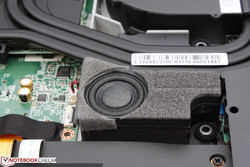
The four top speakers and single subwoofer underneath the notebook provide very good sound quality despite their small sizes. Music playback feels balanced with acceptable bass. Given the girth of the notebook, however, we do feel that the bass could have been even better. Otherwise, maximum volume is very loud to the point where most users will find that even the 30 percent mark can be enough for everyday use. Hardcore gamers will definitely appreciate the high volume where honing in on small sounds can be crucial.
We should note that the Sound Blaster Cinema 2 software that was in our Windows 8 GT80 is not present in our current GT80 running Windows 10. Luckily, a workaround exists for Windows 10 users to install the audio software successfully.
Battery Life
Honestly, nobody is expecting an 18.4-inch SLI gaming notebook to have shockingly long runtimes, so expectations are of course low. Nonetheless, we are a bit surprised by our results. Maximum load on the highest display brightness setting with SLI enabled still clocks in at an hour or less. However, WiFi surfing on the Balanced profile with integrated graphics enabled and at 150 nit brightness (setting 5/10) clocks in just shy of four hours. This is a huge improvement over our original GT80 under the same test conditions.
At its best, we were able to squeeze out a little over 6 hours from the integrated battery by running on Power Saver mode at minimum display brightness and sitting idly on the desktop. Not bad for a notebook over 10 pounds (4.86 kg) and with a massive power adapter measuring 20 x 10 x 4.5 cm.
| MSI GT80 Titan SLI 75 Wh | MSI GT80-2QES32SR311BW 75 Wh | Alienware 18 86 Wh | MSI GT72-2QE16SR21BW 87 Wh | Asus G751JY-T7009H 88 Wh | Eurocom X8 89 Wh | Aorus X7 Pro 73 Wh | |
|---|---|---|---|---|---|---|---|
| Battery runtime | -34% | -18% | 1% | 7% | -25% | -6% | |
| Reader / Idle (h) | 6.2 | 3.2 -48% | 3.4 -45% | 3.8 -39% | 4.5 -27% | 2.5 -60% | 3 -52% |
| WiFi v1.3 (h) | 3.9 | ||||||
| Load (h) | 1 | 0.8 -20% | 1.1 10% | 1.4 40% | 1.4 40% | 1.1 10% | 1.4 40% |
| WiFi (h) | 2.4 | 2.4 | 3.7 | 1.5 |
Pros
Cons
Verdict
The bottom line is if you're going to get an 18.4-inch gaming notebook, then make it the MSI GT80.
With that said, there are a few drawbacks to keep in mind. Its titanic size may imply a wealth of features, but this is not exactly the case. While its half dozen storage bays, 4x speakers plus subwoofer, 3x video-out ports and mechanical keyboard are all very welcoming, we would have liked to see PCIe x4 slots, Thunderbolt, upgradeable CPU, G-Sync display, a full-size keyboard, and higher native resolution options.
Many of these missing features are likely to make it for the inevitable GT80 refresh. The 15.6-inch Eurocom P5 Pro, for example, utilizes a desktop processor and the GT80 successor may do the same. What's more irksome instead are the system's lack of in-depth fan control options and dedicated Macro keys for gaming. The hardware and cooling system are especially well-made, yet even Aorus and Gigabyte with their thin-and-light gaming notebooks can provide better manual fan controls and a handful of Macro keys.
Our configuration allows for plenty of GPU overclocking headroom should users choose to go that route as core temperatures are quite low for a gaming notebook. Official overclocking of mobile Intel CPUs, however, will not be officially supported until the launch of Skylake. Until then, this is as close as you can get to an all-in-one gaming rig.
MSI GT80 Titan SLI
- 08/23/2015 v4 (old)
Allen Ngo




